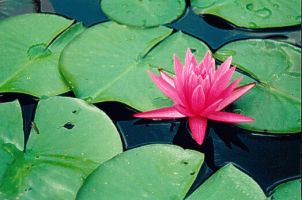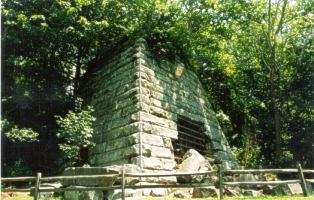| Hocking Hills State Parks - Lake Hope |
click photo to see larger picture |
Lake Hope
A natural paradise, Lake Hope State Park lies entirely within the 18,200-acre Zaleski State Forest in the valley of Big Sandy Run. It is a rugged, heavily forested
region traversed by steep gorges and narrow ridges. Abandoned mines, ancient mounds
and beautiful scenery provide interest and pleasure for hikers, photographers, nature lovers
and historians alike at one of Ohio's most historic and scenic state parks.
Lake Hope State Park lies entirely within the 18,200-acre Zaleski State Forest in the valley of Big Sandy Run. It is a rugged, heavily forested
region traversed by steep gorges and narrow ridges. Abandoned mines, ancient mounds
and beautiful scenery provide interest and pleasure for hikers, photographers, nature lovers
and historians alike at one of Ohio's most historic and scenic state parks.
Nature of the Area
Lake Hope State Park is truly a nature lover's dream. In the forest-draped
hills, the observant visitor can discover the abundant natural resources of this wild and
scenic park.
Although most of the forest was cut to fuel the iron smelting industry that once
flourished here, the land has recovered and supports a magnificent, second-growth forest.
Oak and hickory are the dominant trees while the woodland floor harbors a
fascinating assemblage of shrubs and wildflowers. The yellow lady's slipper ,one of the
rarest and most showy orchids, blooms in secluded hollows. Other spring wildflowers such as
blue-eyed mary, bloodroot and wild geranium can be found in abundance.
Deer and wild turkeys are often seen in a number of park locations. Of the many
animals inhabiting the park, none is as popular as the beaver. As nature's dam builders,
the beavers are found in numbers and can be observed near the quiet inlets of the lake.
History of the Area

Though the roar of the iron furnaces no longer echoes through the hills of
Vinton County, there are many reminders of days gone by at Lake Hope State Park. Situated
at the heart of Ohio's Hanging Rock iron region, Lake Hope State Park reflects the
rich history of much of southeastern Ohio.
The Hope Furnace was built here over 100 years ago to process the iron ore
extracted from the region's sandstone bedrock. The iron resulting from the ore smelting
process was used to produce many different items, including ammunition and cannon for
the Union Army during the Civil War. Hundreds of men labored cutting timber, working the
furnace and driving teams of mules hauling iron ore to the furnace. Charcoal fires were
tended 24 hours a day; so much wood was required for this process that the surrounding
hillsides were almost completely stripped of their timber. At the height of the Hope
Furnace's production, Ohio was one of the nation's leading producers of iron. As time
passed, iron ore was discovered farther west and Ohio's reputation as a major iron producer
waned.
By 1900, nearly all of the major furnaces in southern Ohio were shut down.
Today, the Hope Furnace chimney and some of the foundation are all that remain of the
structure. In the vicinity of the chimney, one may find pieces of slag, the cast-off
residue from the smelting process. These pock-marked, glass-like piece shave now become a
part of the forest floor. The forest we now see is one that has grown back where hundreds
of years ago a primeval forest once stood.
For a time, coal was an important Vinton County export. A number of
mines tunneled into the hills and large quantities of coal were transported out
in ox-drawn coal cars. Most of the mines were abandoned early in this century.
Lake Hope State Park was created in 1949 when the Division of Parks and
Recreation came into existence.
 Dining Lodge
Dining Lodge
The rustic dining lodge, built of native stone and lumber, offers a spectacular
view of the lake. The dining lodge featuresa restaurant, meeting room, snack bar as well
as lodge and cabin reservation office. Souvenirs and firewood are available for purchase.
Cabins
Lake Hope offers family, standard and sleeping cabins for overnight visitors.
All cabins have linens, while the family housekeeping and standard cabins have towels and
complete cooking utensils. Guests at the sleeping cabins must provide their own cooking
utensils. The standard and sleeping cabins are finished in native hardwood and have
wood burning fireplaces. Groups may reserve Laurel Lodge, a rustic structure with a
beautiful stone fireplace, which sleeps 24 persons, provides kitchen facilities and is open
year round.
Camping
A beautiful 223-site campground is suitable for tents or trailers. The
campground includes heated shower houses, pit latrines, waste disposal, laundry facilities,
picnic tables and fire rings. Forty-six sites have electric hookups. Three Rent-A-Camp units
consisting of a tent, dining fly, cooler, cook stove and other equipment, and two
camper-cabins can be rented during the summer months by reservation. Pets are permitted on
a limited number of sites. A group camp is available for organized groups on a reservation
basis. A horsemen's camp is offered for bridle trail users in Zaleski State Forest.
Boating
Boats with electric motors only may be used on the lake. Canoes and rowboats are
available for rent.
Fishing and Hunting
Anglers will find good catches of bluegill, catfish, crappie and largemouth bass
at Lake Hope. Hunting is permitted in the adjacent Zaleski State Forest. A valid Ohio
hunting or fishing license is required.
Swimming
A fine swimming beach is located near the dam. Facilities include a bathhouse
with restrooms, showers and change booths and a concession building where food and
beverages can be purchased.
Picnicking
Picnic areas with tables and grills are located at many secluded and scenic
areas around the park. Two picnic shelters are available on a first-come, first-served
basis or by reservation.
Trails
Fifteen miles of hiking trails traverse the lake and scenic woodlands of the
Lake Hope area and offer opportunities for photography and nature study. In the adjacent
state forest, a21-mile backpack trail with primitive campsites is available. Backpackers
must register upon arrival. Thirty-three miles of bridle trail are available for riders
with their own mounts in the state forest.
Lake Hope Furnace.
Lake Hope Pink Lily.
Lake Hope View of Lake.
State Parks
 Lake Hope State Park lies entirely within the 18,200-acre Zaleski State Forest in the valley of Big Sandy Run. It is a rugged, heavily forested
region traversed by steep gorges and narrow ridges. Abandoned mines, ancient mounds
and beautiful scenery provide interest and pleasure for hikers, photographers, nature lovers
and historians alike at one of Ohio's most historic and scenic state parks.
Lake Hope State Park lies entirely within the 18,200-acre Zaleski State Forest in the valley of Big Sandy Run. It is a rugged, heavily forested
region traversed by steep gorges and narrow ridges. Abandoned mines, ancient mounds
and beautiful scenery provide interest and pleasure for hikers, photographers, nature lovers
and historians alike at one of Ohio's most historic and scenic state parks. 
